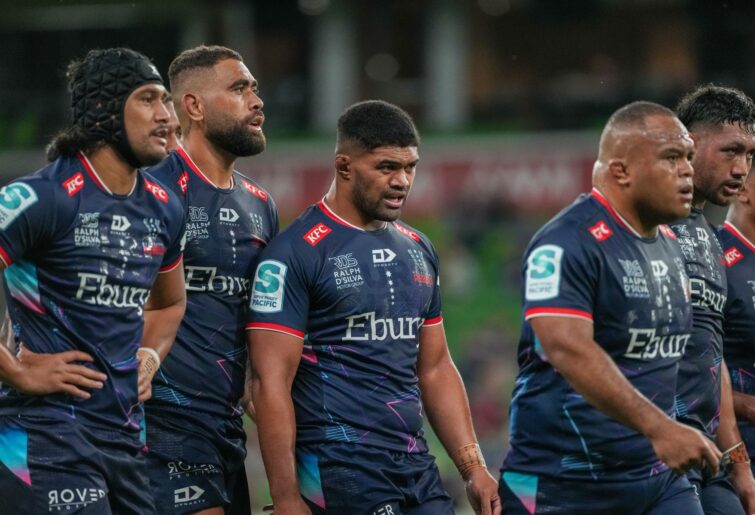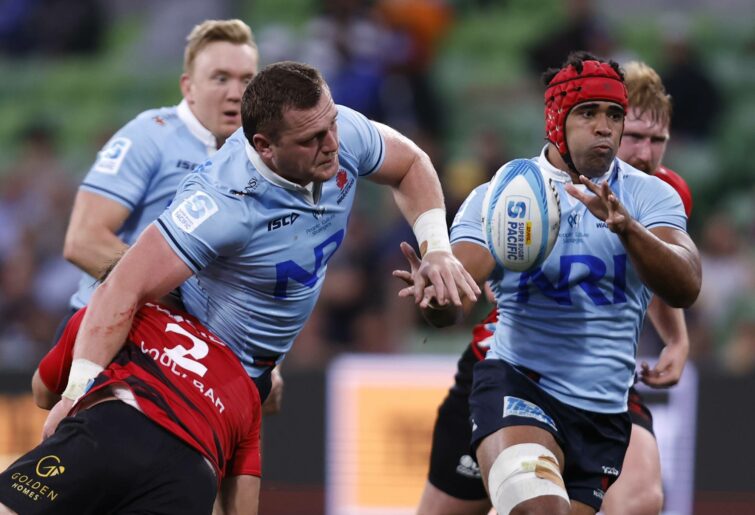Super Rugby closing in on the mid-season point and entering a three-week phase of bye rounds is a reminder of how tenuous the competition really is.
Six matches across a weekend almost guarantees one or two blockbuster clashes, while four matches – depending on how the draw falls – can leave fans feeling a bit short-changed.
With less rugby to fill space, news stories from the non-rugby world seep into the consciousness. For example, we learned over the weekend, who the kind soul was that gave actor Rebel Wilson her first orgasm; at the same time as another actress and model, Liz Hurley, was denying that it was she who gave Prince Harry his.
There was the man charged over urinating into a cup on an Air New Zealand flight – and haven’t we all been tempted to do that? Whilst that old chestnut, a survey on penis length reared its ugly head again; Australian men coming in at 43rd biggest in the world, at 14.4cm.
If that rather modest showing, reminiscent of the Wallabies slipping to ninth in the official World Rugby rankings, feels somewhat disheartening, be comforted by the fact that England – Jonny Bairstow, Owen Farrell and all – registered a miserly 13.1cm.
Nobody begrudges the bye week. It is essential for players and coaches to escape the intense weekly cycle, to rest weary bodies and minds, and to be able to re-set for the next phase of the season.
But rounds of only four matches are problematic for a competition that has found some momentum this year, but which now threatens to slip back into a cycle of predictable outcomes and not enough genuine quality.
All of which made Rugby Australia CEO Phil Waugh’s message to Rebels’ staff, via zoom last Thursday, the more curious. Waugh explained that the primary reason for the delay in any announcement about the future of the franchise was because Rugby Australia and NZ Rugby were waiting for broadcasters to tell it what type of competition it wanted, moving forward.

(Photo by Asanka Ratnayake/Getty Images)
Setting aside whether this is an example of the tail wagging the dog or the dog not knowing what kind of tail it has, it is hard to envisage any TV network embracing less content – a reduction to 11 teams would mean five matches in a normal weekly round instead of six – and paying more money for that.
Alternatively, if the Rebels were to be replaced by a team from Argentina – thus maintaining six matches in a normal weekly round – are we really to believe that Australian and New Zealand broadcasters will pay more for this, than what they would for a Melbourne presence?
As well as the ongoing Rebels’ situation, Super Rugby easing off the pedal also helps divert attention to other pressing off-field matters, such as the ugly, public spat between the NZ Rugby Players Association and NZ Rugby.
Ostensibly a clash over the most appropriate governance model for New Zealand rugby, this stoush is actually rooted in the same factors at the heart of the angst in Australia; a too-small, too competitive commercial market, not enough money to feed all of the rugby mouths that professional rugby demands, and disconnection with people at the coal face of the game.
It was thus ironic – or more correctly, deeply disappointing – that the thing that kept rugby on the map over the weekend was the Fijian Drua’s astonishing capitulation in Melbourne; a 41-20 loss to the Rebels after two players, Frank Lomani and Jone Koroiduadua, were sent off for gross acts of foul play.

(Photo by Robert Cianflone/Getty Images)
At half-time, with the Drua deservedly ahead by 20-15, the Rebels’ coaching team were clear and direct about what was required. Forwards coach Geoff Parling insisted, “If we’ve got advantage, don’t spread and run away from them. Latch tight and take them to a dark place.”
Scrum coach Nick Stiles hammered home a similar point: “Stay on them. We build pressure through our scrum and maul dominance.”
A dark place indeed. When that pressure was duly delivered, it needed a relief valve. Nevertheless, it was a shock to all watching to see the form in which it played out.
For his trouble, Josh Canham copped 20 stitches, four more than his astonishing 16 lineout wins on the night. Or, to put it another way, close to two stitches for every week Lomani potentially faces on the sideline.
Alex Mafi was a whisker away from joining Canham in day surgery; not that the absence of heavy contact will help Koroiduadua, such was the power and intent behind his head butt.
Predicting judiciary decisions is an imprecise science at the best of times. Here, with so few precedents involving blatant thuggery in recent years, there’s an element of the judiciary stepping into uncharted territory.
But with so much focus placed on protecting the head, and players like Sef Fa’agase receiving four weeks for little more than incidental head contact, both Lomani and Koroiduadua – deservedly – look set for a long stretch out of the game.
Compounding the situation, should a now-launched SANZAAR investigation determine that a fan delivered a racial slur to Lomani, it goes without saying that his days at AAMI Park are done.
The head-turning incidents didn’t stop there; referee Damon Murphy somehow deciding from behind that Filipo Daugunu failed to force a grubber kick for a second-half try, when unwanted video evidence suggested otherwise.
Surely the directive to use TMOs more sparingly and keep the game moving doesn’t extend to not using them at all in such close-call try-scoring situations?
After suffering through rain showers, fans in Canberra had to wait until late to see some elite action; Charlie Cale streaking in for a superb team try, capping a solid 40-16 win over the Waratahs.
That try secured a bonus point, although it was a desperate three-man tackle on Dylan Pietsch, after the siren, that maintained it.
If their season wasn’t a lost cause already, it’s hard to see how the Waratahs claw their way back into contention from here; particularly with Angus Bell hobbling off the field with what looks ominously like another serious leg injury.

(Photo by Darrian Traynor/Getty Images)
New Wallabies scrum coach Mike Cron was all smiles and optimism on his first day on the job, last week in Melbourne. He’ll be hoping his second week goes much better than his first.
Missing Ryan Lonergan at general, the Brumbies lacked composure in the red zone in the first half. Cleaner execution came after the break and, now sitting at six wins and one loss, they are well placed to push on for a home final, in June.
Both New Zealand matches finished where many people predicted they would; wins to the Blues 50-3 over the Force, and the Chiefs 68-12 over Moana Pasifika.
Emoni Narawa had a wretched end to 2023, missing out on the World Cup after suffering a back injury. He was due for a day out, and it finally came, the slippery winger running freely and bagging three of the Chiefs’ ten tries.
As ever, Moana Pasifika showed patches with the ball, although they seemed to be suffering under an illusion that having a back-field defence against the Chiefs was not something they needed to bother themselves with. Wrong.
The Force have their bye this week; not a moment too soon, as they take the opportunity to reset before they take on the Crusaders at home, in a fortnight.
That left the Hong Kong Sevens to close off the weekend, the event still holding sway as my longest unfulfilled bucket list item. Maybe next year.

Australia team huddle before the game against France on day one of the Cathay/ HSBC Hong Kong Sevens at Hong Kong Stadium on 5 April, 2024 in Hong Kong, China. Photo credit: Mike Lee – KLC fotos for World Rugby
Two Trans-Tasman semi-finals both went the way of New Zealand, 28-14 in the women’s and 26-7 in the men’s.
New Zealand dominated the women’s final, the USA not securing their first possession until there was 14 seconds left in the first half. 36-7 was full value for a complete squad performance across the weekend.
The men’s final was a much tighter affair, New Zealand edging France 10-7. Lagging on the season ladder, New Zealand’s affinity with Hong Kong continues, this their 14th title. Not quite a dark place but closing in on Fiji’s 19.
































































































